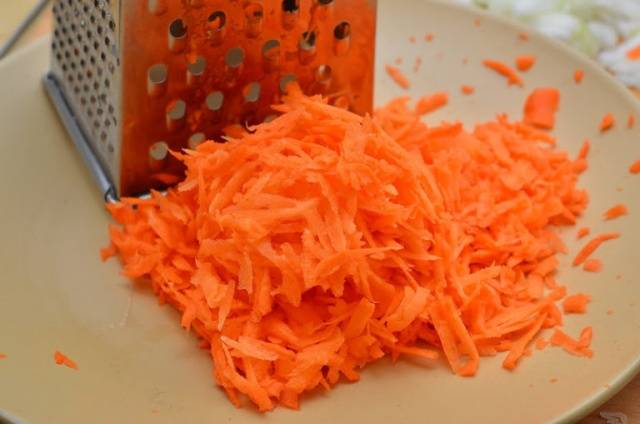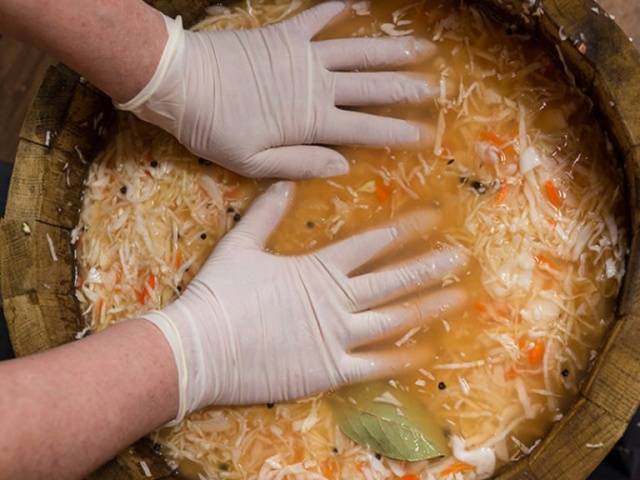Content
It's hard to imagine a family that would be missing sauerkraut. This is the most convenient way to store vegetables in winter. There are a huge number of pickling options. Each housewife has her own little secrets to get aromatic and crispy cabbage.
Many of us remember how in childhood we devoured salads, cabbage soup, pies and pies in the village at our grandmother’s house. Her cabbage was incredibly tasty. Of course, some secrets of sauerkraut have been lost today. But we will try to tell you how to make sauerkraut according to your grandmother’s recipe, so that you can provide your family with a natural product for the winter.
The benefits of sauerkraut
It's not in vain that we talked about pickled cabbage After all, a fresh vegetable loses some of its beneficial properties during storage. But cabbage from a barrel is a real storehouse of health:
- Pickled vegetables contain many times more ascorbic acid than fresh ones. Thanks to this, immunity is maintained at the proper level in winter.
- People who consume pickled vegetables daily suffer from fewer colds. Their gums never bleed.
- This vegetable, fermented according to grandmother’s recipes, is an excellent antioxidant and is involved in metabolism.
- In addition to vitamin C, it contains the entire group of vitamins B and K.Sauerkraut is rich in potassium and sodium, calcium and iron, phosphorus, molybdenum, sulfur and chromium, copper and fluorine and other trace elements. All of them contribute to the rejuvenation of the human body.
It is also useful to eat pickled vegetables because the iodine it contains maintains blood sugar in the desired range.
Which cabbage to choose
Important! To ferment cabbage according to your grandmother’s recipe, you must first select it, because not every vegetable is suitable for this operation.
- Those who have been fermenting white cabbage for more than one year are advised to use only winter varieties. The best are considered “Slava”, “Moscow late", "Siberian", "Stone Head", "Amager". The latter variety is always greenish when cut, but after lying in the basement it becomes snow-white. It is perhaps the most suitable for pickling. Of course, this issue is more difficult to solve in a store, but in their garden they specially grow late-ripening varieties.
- A head of cabbage ready for pickling should be white, juicy, crispy, as in this photo.
- The forks should be large and dense, so there will be less waste.
After fermentation, cabbage becomes soft and bitter.
Grandma's recipe
Of course, today it is not so easy, even using all the ingredients exactly, to get cabbage like our grandmothers did. The fact is that this vegetable is fermented, according to the rules, in an oak barrel. It is its aroma that gives the finished product a unique taste and crunch. And today they salt forks in enamel dishes, in jars, plastic bags.That's why we always lose to grandma's sauerkraut.
Ingredients
If you are fermenting for the first time, start with a small amount of products. For one kilogram of white cabbage forks, according to my grandmother’s recipe, you need to prepare:
- juicy carrots – 1-2 pieces;
- coarse salt (not iodized!) - 1 tablespoon;
- black pepper – 2-4 peas;
- bay leaf – 1-2 leaves;
- dill branches with seed basket.
Pickling process
We don’t start fermenting cabbage for the winter according to grandma’s recipe right away; first we prepare the vegetables:
- We remove the top leaves from the cabbage heads and clean them from the slightest damage. To ferment a vegetable according to grandma’s recipe, we weigh the main ingredient in its purified form, since it is by its weight that we will determine the rest of the ingredients. A lack of salt leads to the appearance of mold, an excess makes it unsuitable for use.
- Cut into thin strips.
- Wash and peel the carrots thoroughly. Wash and dry again. You can shred it in different ways: grind it on a grater, or cut it with a knife. Yes, and grandma’s recipes allow this.
- We cover the bottom of the container with cabbage leaves, put a few branches of dill (without green leaves) and lightly sprinkle with salt.
- Place the chopped vegetables on a clean table, sprinkle with salt and lightly rub with your hands until the juice appears, as our grandmothers did. Add carrots, spices, mix gently again.
- Place in prepared container and compact. We do the same with the rest of the cabbage.
- We do not fill the container to the very top, so that there is space for the juice. It will appear by the end of laying the cabbage.Cover it with cabbage leaves and a sprig of dill on top.
- To pickling for the winter succeeded, the workpiece needs to be pressed down with pressure. Our grandmothers used a birch circle and a special stone. Today, many housewives replace them with a plate and a container of water.
Sauerkraut for the winter should be kept in a warm room for 4-5 days. Usually the container is placed on the floor.
Already on the second day, foam will appear on the cabbage sauerkraut according to grandma’s recipe. It needs to be collected, and the cabbage preparation itself needs to be pierced to the bottom for the winter several times a day so that gases escape. If this is not done, an unpleasant aftertaste will appear. The smell will disappear when the fermentation process is complete.
You can have sauerkraut in winter keep in the cellar, then it is kept in the house for no more than 3 days. If there is no such room, we take it outside into the cold. In this form it is stored even better and does not peroxidize.
Grandma's recipe:
Conclusion
There is nothing particularly complicated about preparing a crispy vegetable according to your grandmother’s recipe for the winter. This procedure can be done even by novice housewives. The main thing is to choose the right varieties of white vegetables for fermentation and follow the recommendations.
Yes, here's another thing: the indicated amount of salt per kilogram of cabbage is approximate. Each variety requires its own amount of this ingredient. To avoid mistakes, taste it. In any case, the chopped cabbage should be saltier than for the salad.















